

 The South African
The South African
Photos kindly supplied by the South African National Museum of Military History, Johannesburg
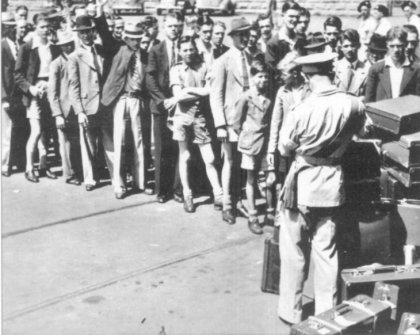
Recruits of all shapes and sizes, many with no previous military experience,
line up to enlist with the Union Defence Force at the beginning of the Second World War.
The following extract from the late H A Candy's 'Memoirs of an amateur artilleryman, 1940-5', written up in March 1997, provides a wonderfully detailed account of the introduction to army life of a young South African university student who volunteered for military service in the Second World War.
The year of 1939 was a momentous one for Europe. Hitler's Nazi armies had gathered into their fold Austria and Czechoslovakia and then, in a lightning strike, had swept into Poland. In response, Britain and France declared war on Germany. For the next six months or so, Western Europe experienced a lull in hostilities which came to be known as the 'phoney war'. In April 1940, Denmark and Norway were overrun by German troops. In the following month they again displayed their swift and ruthless power by surging through the Low Countries and rampaging through France, compelling the evacuation of the British Expeditionary Forces from the beaches of Dunkirk.
Enlistment
The Union of South Africa joined the rest of the British Commonwealth in declaring war on Germany, although the white population of the country was deeply divided over the issue. It was of special significance that Italy, under Mussolini's Fascist rule, was showing signs of aggression in her African possessions of Libya, Abyssinia, Somalia and Eritrea. The Union Defence Force was, by now, fully engaged in recruiting and training volunteers for overseas service. Despite the prevailing atmosphere of gloom, there was, among many university students, a heightened sense of excitement, born, no doubt, of a lack of the real experience of war. It was during this depressing period that Max Castle, partially blind in one eye, Stan Wilson, Eric Fitchett and I decided to take the plunge and volunteer for military service. All four of us had completed Bachelor degrees. Three were engaged with studies towards teaching diplomas, while I was committed to a research programme leading to a Master's degree. It was a cool Pietermaritzburg night when we walked the two kilometre stretch down Commercial Road, over the Umsunduzi Bridge, and into the headquarters of the Natal Field Artillery. Apart from learning left from right during a brief cadet course while at school, none of us had any substantial knowledge of the army and its ways. Induction into the regiment was a surprisingly simple and painless affair - signatures on one or two forms (one of which included the phrase 'for four years or the duration of the war, whichever is the shorter period') and a quick visit, in the nude, to the medical officer (MO) and - bingo! - we were instant, albeit very raw, gunners. Thus we crossed the divide from 'civvy' to army life and suddenly the courtesies, so generously displayed at reception, vanished. It was abundantly clear that we were now at the bottom of the pile.
With the permission of the university, we were allowed to continue to occupy our rooms in Residence and, for about a month, dressed in civilian clothes - no uniforms were available - we spent the mornings learning some intricate footwork on a hot and dusty parade ground. Afternoons were spent partly on gun drill and partly on lectures relating to the principles of gunnery practice. Having no modern artillery pieces, we were resigned to honing our gun drill on 18-pounders, pieces used in the First World War. All these energy-sapping activities were supervised by regular army sergeants who strutted and stamped about, barking commands often interspersed with unprintable expletives. Weeks passed before a stack of military paraphernalia arrived, including cork helmets, boots, uniforms, webbing, badges, buttons, and so on. On command, there was a frantic rush to find bits and pieces to fit our various body shapes - tall, thin, short, stout. There were no fitting rooms here with genteel attendants draped with tape measures, no soft spoken footwear experts to ensure a comfortably fitting boot. A few days spent on bartering, however, and all was almost set to rights. A few more weeks passed when the order came for the regiment to proceed for full-time training at the Artillery School and Training Centre, Potchefstroom, situated in the western Transvaal.
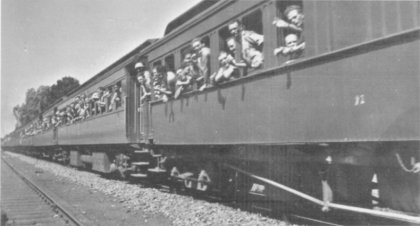
South African troops on board wave enthusiastically as their troop train moves off.
Artillery Training Centre, Potchefstroom
It was mid morning in June 1940 when the regiment marched in columns of three from their preliminary training centre in Pietermaritzburg. A bright, wintry sun shone down while a cool breeze chased dry leaves among the trampling boots as we were led by a pipe band along Commercial Road, past the cemetery and its uncomfortable neighbour, Grey's Hospital, past Merchiston Preparatory School and into the heart of the city. At the City Hall, a left wheel brought the column into Church Street. The skirl of pipes and tramp of foot drew shoppers and office workers to the pavements, clapping and shouting encouragement. Blood ran faster in our veins as we marched tall despite our 'rookie' status. At the far end of the long street, a troop train stood waiting. By nightfall, the train had long since traversed the forest-clad slopes of Blackridge and Town Hill, the scarp which hugs the western boundary of the city. We hurried on with no stops, through Estcourt, Mooi River, and Ladysmith, towards the high Drakensberg Mountains. Then on past Majuba (the Mountain of Doves), and onto the frosty expanse of the Transvaal Highveld. Conversation in the compartmentfaded and gave way to the monotonous 'clack-clacking' of the wheels, punctuated by occasional snoring. The Artillery Training Centre was reached the following morning. It lay close to the rural town of Potchefstroom, at an altitude of about 2 000m and roughly 100km west of Johannesburg. The camp occupied a large tract of rolling veld, small peaked 'koppies' (hills), and rocky ridges. A few dusty vehicle tracks criss-crossed the surface, meandering through numerous drifts of 'doringboom' (thorny Acacia trees). At that time, during winter, these characteristically umbrella-shaped trees were in bloom and imparted a wonderful fresh mimosa fragrance to the atmosphere. In one corner of this vast tract, stood the stark brick-and-iron administration block. Close by sprawled several tent villages, one of which was to be the 'home' of the regiment for some months to come.
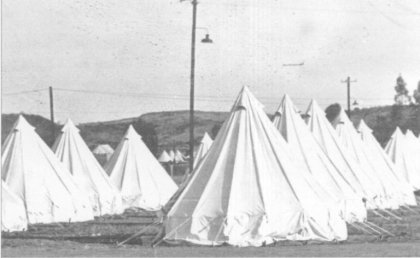
Tented camp accommodation for the enlisted troops.
Officer training
Within two weeks of our arrival, I was selected to join a Cadet Officer's course. Regulations forbade cadets from fraternising with their erstwhile gunner companions, a sad blow to our long-standing friendship. In the main camp there stood a large marquee, serving as an entertainment centre for the troops. With a little careful planning, myoid friends and I managed to meet here periodically. Shrouded in a dusty, smoky atmosphere and struggling to hear each other above the din of loud music, we managed to maintain contact, albeit for a limited time. Memory plays strange games. Today [1997], on hearing the tune of a popular melody from those days, 'Over the rainbow', sung fifty years ago by child singer Judy Garland, I am immediately transported back to that noisy, dusty atmosphere with crystal clarity.
With two cadets to a tent on the course, I had the good fortune to share with Frank Shaw, KC, a man prominent and popular in the Pietermaritzburg legal fraternity. Frank was a tall, heavily built man, greying at the temples and some years older than me. It surprised us all to learn that he had risen from the ranks in the First World War to become an infantry officer and now, 25 years later, he had volunteered to start all over again! Inevitably, after finishing the course as Senior Cadet with some experience in the field, he rose to a high rank, becoming a staff officer with legal responsibilities.
For training purposes, the cadet battery was in the hands of two officers and a sergeant-major. Captain Kay, a young and enthusiastic gunnery officer, with his soft cap set at a jaunty angle, put us through many gruelling gun drill and field exercises. We manhandled the old 18-pounders through ditches, over rocks, in rain and in the hot sun and, with the aid of ramps, onto flat trucks as portage vehicles. His commands were always prefixed with 'bauwee .. .', his own shortened version of 'battery'. The domain of the parade ground, that dazzling, biscuit-coloured gravel square, belonged to Lieutenant Robbertze, a dour Afrikaner with an intense sense of discipline, and immaculately dressed on every occasion. He reminded me so much of a school teacher, a Mr Winter, another dour Afrikaner who taught his language with great fervour. Standing next to one's desk, he responded with glee to any error on the part of the student by twisting the short hairs close to one's ear. It was patently clear from the outset that Lt Robbertze had set himself the task of extracting from us the utmost in discipline and precision on that sacred square. Suffice to say, he bent us to his will with exceeding efficiency. Administration of the battery's affairs was in the care of a Sergeant Major du Preez, an old-style warrant officer, zealous in his duties but capable of displaying humane qualities when the occasion arose. He once quipped 'These 18-pounders and I grew up together. When I was a gunner, there were only 14-pounders (an earlier version)'. Among the cadets he was secretly referred to as 'Mother du Preez'.
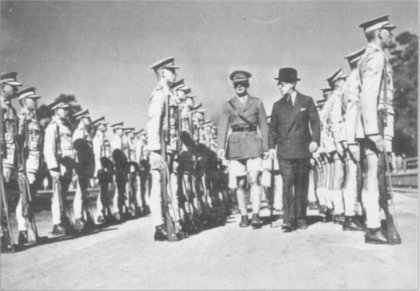
The Administrator of Natal inspects troops as they stand to attention.
It was always a scramble to be ready for the 06.00 pre-breakfast parade and inspection - knock icicles off leaky taps at the open-air basins, have a quick wash and shave, follow a fast dressing routine with the inevitable struggle with those wretched puttees, grab one's meticulously cleaned rifle and helmet, and end off with the 800m dash for the 'square'. On one such occasion, Cadet Hughes, pressed for time and managing to reach the parade ground only just in time, had unwittingly donned his cork helmet back to front. The crunch of boots on gravel signalled the approach of the inspection party. Lieutenant Robbertze reached Hughes, studied him briefly, turned and passed a comment to Sgt Maj du Preez and moved on. The sergeant-major, stony-faced and with a swagger-stick tucked tightly under his arm, stood foursquare before Hughes, eyeball to eyeball. 'Cadet Hughes!' he held, 'Is you comin' or is you goin' [sic]?' There was a pause before he continued: 'Get that b.... headdress on right! Saturday leave pass cancelled!' The gentle crunch of boots continued down the line of men.
After courses in day and night orienteering, military law and the standard field exercises, examinations were written. Two weeks of intense foot and rifle drill brought the course to an end. There followed a modest 'Passing Out' parade, attended by senior officers in full plumage and a handful of fond parents and friends. Gone was the white cap band, the insignia of a cadet, and a whole new challenge presented itself.
No time was lost in posting this fresh batch of second lieutenants. Three of us had the honour of being transferred to 2nd Battery, 1st Field Regiment. This artillery regiment, originally listed as the 'Cape Town Volunteer Artillery' in 1857 and having lived through many name changes, was the senior regiment of the Union Defence Force. Immediately before the outbreak of the war, it had been known as the Cape Field Artillery, or, more commonly, the CFA. The advent of the war had called for a reorganisation of the artillery corps and all 'locality names' had been replaced by numerical titles. The men of 2nd Battery, recruited in the Transkei, Eastern Cape, were mainly trading store owners, tradesmen and businessmen from small district towns. Interestingly, a number were of German descent and hailed from villages with German names, such as Berlin and Stutterheim.
Anti-Gas Training
The following months were devoted to moulding the group of inexperienced men into a fighting unit. The only artillery pieces that these recruits had seen were those displayed on monuments, and the only ones that they had actually laid their hands on were 'mock-ups' constructed from rain pipes and cartwheels. So the old 18-pounders were again called into service. During this extensive period of training, it became necessary to appoint one officer from each of the three batteries to assume responsibility for protection of the battery against possible gas attacks. With my knowledge of chemistry, I was the obvious choice from 2nd Battery.
A course was run on a regular basis at Voortrekkerhoogte, the main centre of the Union Defence Force, located a few kilometres from Pretoria. This venue was the 'home' of the regular army and was staffed mainly by Afrikaners; their influence in evidence at every turn. The three of us were transferred to Voortrekkerhoogte and, dressed in the regulation brown overalls with no rank badges, joined a squad of about twenty. The course was thoroughly pragmatic, involving the use and testing of anti-gas capes and masks, the types and nature of gases that we might encounter, and some field exercises. One of these required the squad to be locked in a small corrugated iron hut and to make it gas-proof with any material we could find. Some old newspapers and a bucket each of water and sand were supplied. After about 30 minutes, several tear-gas bombs were set off around the outside of the hut. Despite our serious efforts, the difficulty of completely gas-proofing a room of this nature became clear when we were all suffering from the effects of the gas within fifteen minutes. A second exercise involved the careful fitting of respirators, after which we were required to walk for about 300m through a smoke screen laced with teargas. It was an eerie and unpleasant experience. The respirator impeded our breathing, the hot sun caused us to sweat excessively, and the goggles fogged over, impairing our vision. To successfully engage in combat under these conditions seemed almost impossible. On our return to the regiment, it was our responsibility to ensure that each man in our respective batteries was fitted with a respirator and persuaded of the importance of maintaining this equipment. The procedure was checked by having the whole regiment pass, in single file, through a deep, covered trench, about fifteen metres long, into which teargas had been released.
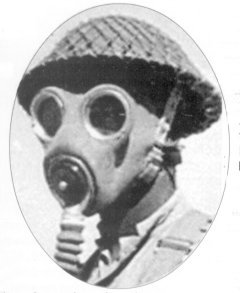
Gas masks such as this one were uncomfortable but essential anti-gas equipment for the troops.
Tale of a Pet
The keeping of pets in camp was, of course, forbidden. However, in every group there will always be someone prepared to break the rules. In our battery, Lieutenant 'Boots' Botha filled this role. He captured and became attached to a wild, rat-like creature which he tethered by a long string to the tent pole of his quarters. With the occasional 'doggy bag' from the mess, it dined well and, being of nocturnal habit, the chances of it being discovered were slim. After a feeding session one evening, 'Boots' was bitten on the finger. His 'tent-mate', the pet, died about an hour later. 'Boots' thought nothing of it and buried the little carcass. In the mess later that evening, he joked about the incident and became the focus of some light-hearted ridicule-'animal bites "Boots" and promptly dies!' When the joke reached the ears of the MO, however, the mood changed dramatically. Lt Botha was ordered to retrieve the remains of his pet and to proceed immediately to a medical institute in Johannesburg. He spent the next few days receiving painful abdominal injections while the animal carcass was tested for rabies. The results proved to be negative, but the exercise served as a salutary lesson to all.
The wait
Time passed more and more slowly with no news of new equipment or of any move closer to the action. The monotony was partly allayed by occasional leave passes. Many of the men had friends or relatives who, having enlisted at the beginning of the war, were already helping to bring the Abyssinian campaign to a close. Such news gave rise to feelings, amongst the men of our camp, of having been left out of the action. Rumours emerged, drifted about, and vanished, a not uncommon phenomenon among troops who, of necessity, were not privy to classified information. Then, suddenly, on a hot morning in May 1941, things began to change. The men of the 1st Field Regiment were ordered to assemble on the parade ground in single file while the MO and his orderlies set about delivering immunisation 'jabs' against cholera and other diseases. Expectations soared. A day or two later, we received two 'dog tags' - those almost indestructable bits of plastic, about the size of an old twenty cent coin, that served as identification discs. Inscribed very simply with one's name, army number (89747 in my case), and religion, it was a chilling thought that these little tablets, hung around one's neck, 'never to be removed at any time', might one day be the only evidence of one's fate in war. Shortly afterwards, two regiments were assembled for a 'pep' talk from a high ranking officer who ended with the comment: 'Remember, war is 95% boredom and 5% sheer fright.'
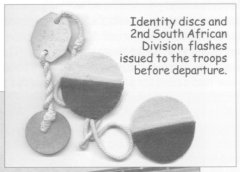
Identity discs and 2nd South African Division flashes
issued to troops before departure.
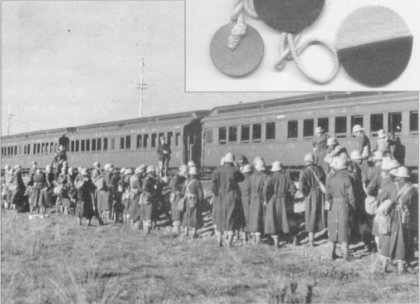
South African soldiers board a troop train.
Finally, to Egypt
On 6 June 1941, I volunteered to join Major Pope, Capt McWilliam, Lt Power and about 170 men as an advance party to proceed to Egypt to prepare a camp for the main body and to receive our long-awaited new equipment. Four days later, we were delivered to 'A' Shed, Durban Harbour, where we were to embark on the prestigious French luxury liner, Ile de France. A leave pass allowed me to spend the night at home, enabling me to make contact with my girlfriend, Solveig, who was teaching 150km away, in Empangeni, Zululand. Somehow she managed to race down to Durban and we spent a couple of hours together, watching the sun rise over the Indian Ocean. At 09.00, to the sound of 'Sarie Marais', an old South African folk song, and much shouting and waving, the Ile de France, in the company of two other majestic vessels, the Mauretania and the Nieuw Amsterdam, sailed from Durban with HMS Cornwall as escort. Adding some zest to the departure was a message picked up on radio from the German propagandist, 'Lord Haw-Haw', 'wishing the advance party of the 2nd South African Division a pleasant voyage to Egypt'. What price classified information? Each of the three ships carried about 4000 men and the luxurious Ile de France, appointed for trans-Atlantic trips, had not been properly converted for troop transport. With the strict imposition of black-outs, nights were almost unbearable during the passage through the Red Sea, particularly for the other ranks, crammed into every nook and cranny below decks. Many dragged their bedding onto the open decks.
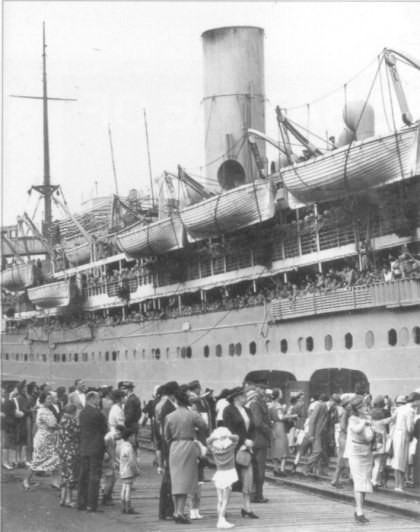
A fully-laden troopship prepares to leave Durban Harbour for the war zone in the north.
Ten days later, without mishap, we arrived at Port Taufiq, close to Suez, at the southern entrance to the Suez Canal. Two half-submerged officials were in great haste to have us off the ship and safely away by train. First impressions of Egypt were not flattering as we wound our way through the towns of Ismailia, Zagazig, Tanta and Damanhur, all unkempt and decrepit. At one or two stops, we were overwhelmed by ragged youngsters, flies crawling over their runny noses and into their watery eyes. Endlessly they beseeched us 'baksheesh, baksheesh' ('gift, gift'). A few adults carried fly whisks and used them continually. The canals, criss-crossing the Delta, were strips of dark water, polluted and evil-smelling. Undoubtedly, the warning received earlier of health problems was no myth. Eventually we reached the open desert, but it was not the glamourous, golden, windrippled sand hills so often depicted. Instead, we detrained at a lonely railway siding set in a vast expanse of dust and stones dotted with short, distorted shrubs, harsh to the touch, known as 'salt bush'. The siding bore the name Amariya. Not far from it was our camp site at Mareopolis, l0m above sea-level, a patch of dry, hot sand. A half-hour's drive from our camp brought us to a view of the important naval base of Alexandria. We soon recognised two peculiarities about the desert. Firstly, every salt bush harboured a family of brown scorpions which were not averse to seeking shelter in boots, sleeping bags, folds in tents, etc. Secondly, and surprisingly in this great expanse of dry, empty land, the number of flies which were our constant companions would explode into a countless swarm if a tin of food was opened outside the protection of a mosquito net. It would have been impossible to dip into a tin of jam without mutilating a dozen of so of these docile, lethargic and annoying little creatures. We had arrived in Egypt.
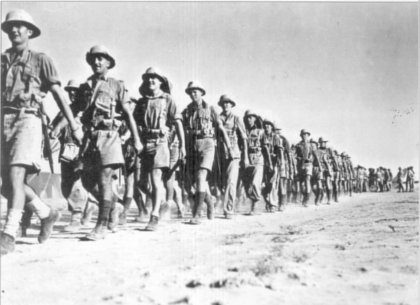
Battle-trained South African troops march in line in the North African desert.
Acknowledgements The editor would like to thank Mrs Solveig Candy for granting permission for the publication of her late husband's material, and Professor Mike Laing of the University of KwaZulu-Natal, Durban, for making all the necessary arrangements in this regard.
Return to Journal Index OR Society's Home page
South African Military History Society / scribe@samilitaryhistory.org